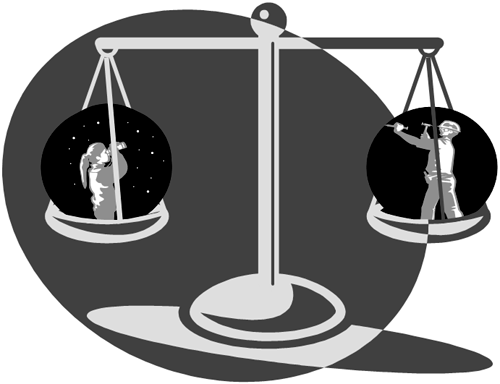23.3. Knowing How You're Going to Get There
Customer Relationship Manage is actually very simple; but it's not easy. First, there is no magic wand. Successful CRM programs occur when your organization is ready to invest the time and energy required to successfully manage communications and work across all the front office business functions and Information Technology. You need to be able to successfully balance your dream of what the future can look like and the time and sweat needed to make it all happen (see Figure 23-4).
Figure 23-4. Balancing dreams and sweat

It's critical to know where you plan to take your CRM program and what path will get you there while addressing the company's most important business priorities. Setting realistic expectations within the organization—and repeating them—is critical, because there are no shortcuts for doing the work. There is no magic.
23.3.1. There Is No Magic
CRM programs take real work and involvement from key people within your organization. But there is a piece of “magic” that all companies have available to them, although they don't often use it. Common sense goes out the window with the promise of all the wonders that CRM will bring.
Of course, common sense isn't really magic. It just looks that way sometimes when the occasional program team decides to take charge of the program and use their business knowledge and experience to set priorities, identify requirements, and decide on scope.
23.3.2. Use Strategic Vision and Take Small Steps
Dreams are about painting a vision of where you want to be. Dreams should not be limited by common sense. Instead, reach for the sky. Dreams should always stretch the imagination. They are too big to be done overnight (since there's no magic involved). As you work to achieve your vision, you must identify small, high-priority projects that have specific, limited, clear objectives that you can measure.
CRM projects are the small steps we take to achieve our vision. In addition to being clear and measurable, the objectives must be linked to a well-defined customer offer with a measurable response (e.g., a product launch, upgrade campaign, new CRM customer functionality). In Chapter 19, we introduced the CRM continuum shown in Figure 23-5. The continuum illustrates that you should repeat these small projects until you've achieved the level of CRM functionality that is right for your company. The projects are always guided by your strategy and vision, and the vision and strategy are evolved based on project results and changes in the environment.
Figure 23-5. CRM continuum = baby steps

Each project cycle starts from the strategic plan, focusing on just the elements that are relevant to the current project. Each project cycle ends by comparing the results to the current strategy and vision and incorporating into the strategic plan anything that was learned or that has changed. The updated strategy is then used to launch the project having the next highest priority.
23.3.3. Bridging Organizational Disconnects with Organizational Support and Communication
It's been said that our ability to communication is what separates man from beast. Don't you wonder sometimes whether the animal kingdom has taken control of your company? The most important result of effective communication is to achieve understanding. All CRM programs fail if there is no common understanding between the business functions and the IT team, yet these two sets of people generally have little in common—not even a common language at times. (Of course, the same could be said for some sales and marketing organizations, and even more so for product support and customer services.)
We use formal organizational structures and project management methodologies introduced in Chapter 10 to clarify roles, responsibilities, and expectations between the various important organizations. Different experts with different skills must work together to make sure that technical results meet business expectations, as illustrated in Figure 23-6.
Figure 23-6. The project team

Of course, the project manager plays a key role in keeping the work on schedule and eliminating misunderstandings within the project team. The project manager and the program manager together are responsible for communication with the extended program management organization.
